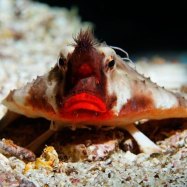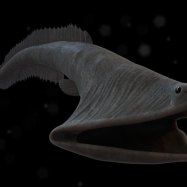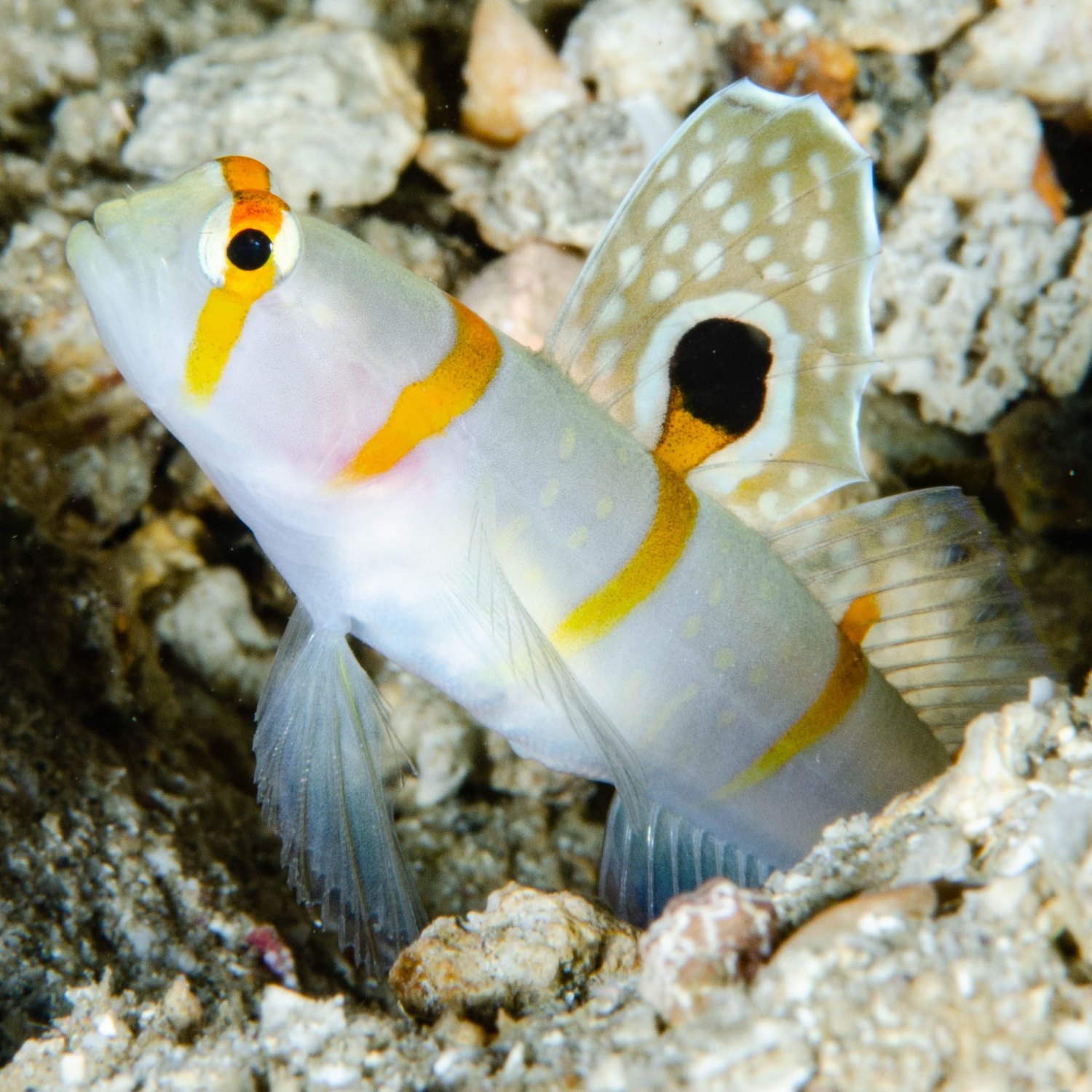
Goby Fish
Varies depending on species, but typically ranges from 1 to 4 inches
Goby fish may be small, but they are mighty swimmers found in oceans, rivers, and lakes. With a slender and elongated body, these creatures come in a variety of colors and can grow up to 4 inches long. As a part of the Gobiidae family, these little fish are a vital part of many aquatic ecosystems. Have you ever spotted a Goby fish during a swim? #FishFacts #GobyFish #AquaticLife.
Animal Details Summary:
Common Name: Goby Fish
Kingdom: Animalia
Habitat: Marine and freshwater habitats
Goby Fish: The Remarkably Adaptable Creatures of the Water
The underwater world is full of breathtaking creatures, each with its unique characteristics and adaptations. Among these magnificent creatures is the Goby Fish, a small yet fascinating creature that has captured the attention of many marine biologists and enthusiasts. With its vast geographical distribution, colorful appearance, and remarkable adaptability, the Goby Fish has become a subject of interest for scientists and a beloved companion for aquarium owners.The Basics: What is a Goby Fish?
The Goby Fish, or Gobioidei in the scientific world, is a small, slender fish that belongs to the class Actinopterygii Goby Fish. They are categorized under the order Perciformes and the family Gobiidae, which consists of more than 2,000 species. With such a vast number of species, the Goby Fish comes in a range of sizes and colors, and each one has its unique adaptations based on their specific environments.This cosmopolitan family has a widespread distribution, making it one of the most diverse and adaptable fish in the world. They can be found in both marine and freshwater habitats, allowing them to thrive in various environments across the globe. These remarkable creatures have also been scientifically classified as part of the Animalia Kingdom and the Phylum Chordata, making them closely related to other fascinating sea creatures such as whales, dolphins, and sharks.
Discovering the Habitat of the Goby Fish
The Goby Fish is known to be incredibly adaptable and can thrive in various habitats worldwide. They are found in oceans, lakes, rivers, and even mangrove swamps. They are most commonly found in tropical and subtropical regions, but some species have made their homes in the colder waters of the Northern Hemisphere.One of the remarkable things about the Goby Fish is their unique ability to adjust to their surroundings Giant Panda Bear. They are well-known for their adaptability, making it easy for them to survive in different environments and even thrive in areas where other fish species struggle to survive. This makes them an excellent example of how diverse and flexible marine life can be.
Feeding Habits of the Goby Fish
The Goby Fish is a carnivorous creature, meaning their diet consists mainly of meat. They are opportunistic feeders, and their diet varies depending on their habitat and available food sources. Some species of Goby Fish are bottom-feeders, while others are known to feed on small fish, shrimp, and other marine organisms.These small yet efficient predators have adapted to their environments and have developed unique hunting techniques. Some swing their heads from side to side as they search for prey, while others have elongated jaws that they use to snatch food from small crevices.
A Rainbow of Colorations
One of the most fascinating features of the Goby Fish is its colorful appearance. While the coloration of these fish varies depending on their species, they often have shades of brown, green, and gray. These colors help them blend into the environment, making them less visible to predators.Some species have striking patterns that make them stand out, while others have spots or stripes that help them camouflage. Some Goby Fish have even evolved to change their colors to match their surroundings, which is an incredible defense mechanism to avoid becoming prey.
The Unique Body Shape and Length of a Goby Fish
The body shape of the Goby Fish is slender and elongated, making it easy for them to navigate through small crevices and tight spaces in their habitats. This shape also allows them to be swift and agile swimmers, making it possible for them to escape predators and catch their prey.The length of the Goby Fish varies depending on their species, but it typically ranges from 1 to 4 inches. Some species are known to grow up to 12 inches, while others remain tiny at only 0.5 inches. Regardless of their size, these fish pack a lot of character and beauty in their small bodies.
The Fascination Behind the Goby Fish
There are numerous reasons why the Goby Fish has captured the attention and curiosity of people worldwide. From its remarkable adaptability to its diverse appearance, these creatures continue to fascinate scientists and enthusiasts alike.Their ability to thrive in different environments and adapt to various food sources has puzzled marine biologists for years. They have even captured the attention of AI engineers, who have studied their underwater skills to develop advanced robotic technology.
What's more fascinating is that some species of Goby Fish have developed unusual symbiotic relationships with other creatures. For instance, some species have been found living in the burrows of pistol shrimp, providing protection for themselves while also benefiting from the shrimp's food scraps.
Their unique hunting and foraging techniques have also been a subject of interest for scientists. Some species use bioluminescent bacteria to lure their prey, while others have developed specialized fins and jaws to eat invertebrates and small fish.
Threats to the Goby Fish and Conservation Efforts
Despite their remarkable adaptability, the Goby Fish population faces threats from human activities and environmental changes. Habitat destruction, pollution, overfishing, and the introduction of invasive species have all contributed to the decline of some Goby Fish species.Thankfully, there have been efforts to conserve and protect the Goby Fish population. The International Union for Conservation of Nature (IUCN) has listed some species as "vulnerable" or "endangered," and there are ongoing conservation projects to protect their habitats.
The rise in aquarium hobbyists has also led to more awareness and appreciation for these magnificent creatures. Many aquariums have designated areas and tanks, specifically for Goby Fish, allowing people to learn more about them and witness their beauty up close.
Bringing the Goby Fish Home
If you've been captivated by the unique features and adaptability of the Goby Fish, you may be considering bringing one home as a pet. However, it's essential to understand that these fish require specific care and conditions to thrive.First, it's crucial to research the specific species you're interested in and understand its natural habitat, feeding habits, and unique care requirements. Some species are best kept in a specific water temperature or with a particular food source.
It's also important to ensure you have the right equipment and space to maintain a healthy aquarium for your Goby Fish. They thrive in tanks with plenty of hiding spaces, rocks, and plants, mimicking their natural environment.
The Amazing World of the Goby Fish
In conclusion, the Goby Fish is a fascinating creature that has intrigued scientists and captivated aquarium owners with its remarkable adaptability and diverse appearance. With their vast distribution, unique hunting techniques, and colorful patterns, the Goby Fish is a perfect example of the incredible diversity of marine life.While they may be small in size, the Goby Fish continues to inspire awe and curiosity, reminding us of the vast and remarkable world that lies beneath the ocean's surface. As we continue to learn more about these creatures and their unique adaptations, we can appreciate and protect them for generations to come.

Goby Fish
Animal Details Goby Fish - Scientific Name: Gobioidei
- Category: Animals G
- Scientific Name: Gobioidei
- Common Name: Goby Fish
- Kingdom: Animalia
- Phylum: Chordata
- Class: Actinopterygii
- Order: Perciformes
- Family: Gobiidae
- Habitat: Marine and freshwater habitats
- Feeding Method: Carnivorous
- Geographical Distribution: Tropical and subtropical regions worldwide
- Country of Origin: Various countries
- Location: Oceans, rivers, and lakes
- Animal Coloration: Varies depending on species, but often includes shades of brown, green, and gray
- Body Shape: Slender and elongated
- Length: Varies depending on species, but typically ranges from 1 to 4 inches
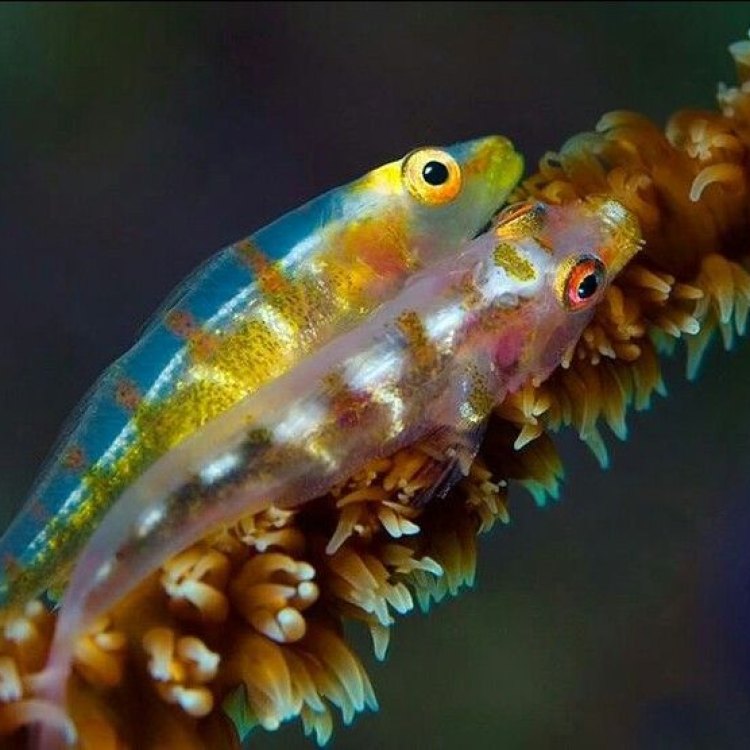
Goby Fish
- Adult Size: Varies depending on species, but typically ranges from 1 to 4 inches
- Average Lifespan: Varies depending on species, but generally ranges from 2 to 5 years
- Reproduction: Sexual
- Reproductive Behavior: Depends on species, but typically involves courtship rituals and laying adhesive eggs
- Sound or Call: Some species can produce sounds using their swim bladders
- Migration Pattern: Varies depending on species
- Social Groups: Some species live in groups, while others are solitary
- Behavior: Varies depending on species, but goby fish are generally territorial and have complex mating behaviors
- Threats: Habitat degradation, pollution, overfishing
- Conservation Status: Varies depending on species
- Impact on Ecosystem: Goby fish play an important role in aquatic ecosystems as they are bottom-dwelling species that help regulate populations of prey species and contribute to nutrient cycling
- Human Use: Goby fish are sometimes kept as pets in aquariums
- Distinctive Features: Large pectoral fins, fused pelvic fins forming a suction cup, a non-protrusible mouth, and camouflaging coloration
- Interesting Facts: Some species of goby fish have unique adaptations, such as the ability to climb vertical surfaces using their suction cup-like pelvic fins
- Predator: Varies depending on species
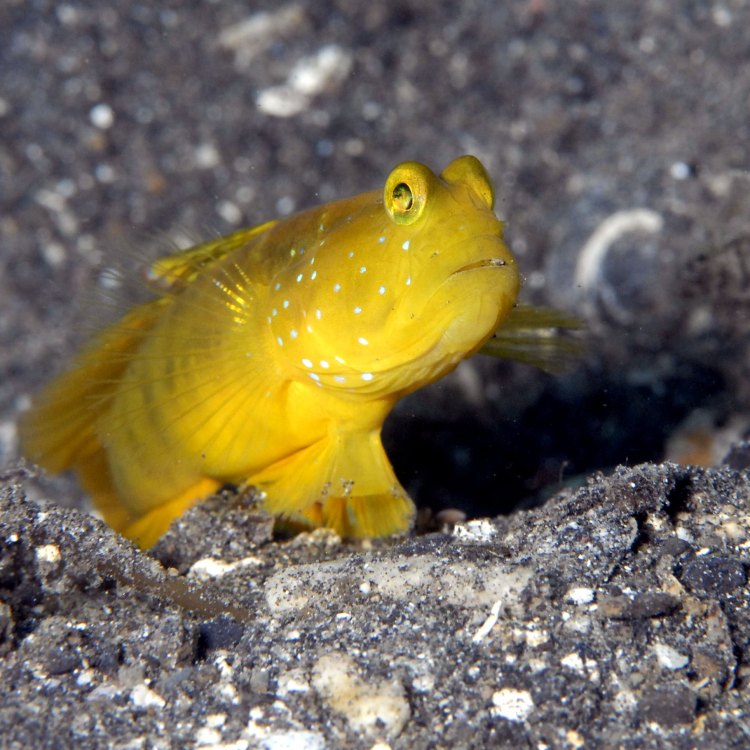
Gobioidei
The Intriguing World of Goby Fish: Exploring the Marvels of This Unique Aquatic Species
Deep beneath the vast blue waters of our oceans, there exists a fascinating and diverse world of aquatic creatures. Among them, one family stands out with their distinct features and interesting behaviors - the Goby fish. Found in various marine and freshwater habitats around the world, these small but mighty fish have captured the attention of researchers, aquarium enthusiasts, and nature lovers alike.With a varied range of species, each with its unique set of characteristics, the Goby fish family has something special to offer PeaceOfAnimals.Com. From their distinctive physical features to their complex social behaviors, there is much to discover about these intriguing creatures. So let's dive into the world of Goby fish and uncover their secrets.
Size and Lifespan
First and foremost, let's talk about the size and lifespan of these fascinating fish. The size of Goby fish can vary depending on the species, but on average, they range from 1 to 4 inches in length. This makes them quite small compared to other aquatic species. However, what they lack in size, they make up for in their unique features and behaviors.
In terms of lifespan, Goby fish can live for anywhere between 2 to 5 years on average. Again, this can vary depending on the species and their environment. Some species have been known to live for up to 8 years in captivity, while others have a shorter lifespan in the wild Green Aphids.
Reproduction and Reproductive Behavior
Like most aquatic species, Goby fish reproduce sexually. However, their reproductive behaviors can vary depending on the species. Generally, it involves courtship rituals and the laying of adhesive eggs. Some species, like the neon goby, have a complex mating behavior where the female leads the male to her chosen nesting site and lays her eggs there. The male then guards and cares for the eggs until they hatch, emerging as tiny larvae ready to explore their surroundings.
Other species, like the Yellownose goby, have a different approach to reproduction. They build their nests in empty shells or small holes in rocks and attract females by producing drumming sounds using their swim bladders. Once the eggs are laid, the male diligently guards them and even fans them with his pectoral fins to keep them oxygenated.
Migration and Social Groups
Goby fish have various migration patterns depending on their species. Some species, like the bluebarred goby, are known to migrate seasonally, while others, like the twostripe goby, stay in one location throughout their lifespan.
In terms of social groups, Goby fish can either live in groups or be solitary depending on their species. Some, like the cleaner goby, are known to form symbiotic relationships with larger creatures such as shrimp, where they clean their bodies of parasites. This cooperative behavior allows them to live in groups and have a mutually beneficial relationship with their larger counterparts.
Behavior and Threats
The behavior of Goby fish is as varied as their colors. While some species are peaceful and social, others are territorial and can be quite aggressive. For example, the fire goby is known to be fiercely territorial and will often defend its chosen piece of coral fiercely. They have even been observed to attack and chase away other fish that come near their territory.
Unfortunately, Goby fish are facing numerous threats, particularly due to habitat degradation, pollution, and overfishing. As bottom-dwelling species, they are often among the first to be impacted by changes in their environment. Their populations are also at risk due to pollution and overfishing, which can lead to a decline in their numbers and impact the balance of the ecosystem they are a part of.
Conservation Status and Impact on Ecosystems
The conservation status of Goby fish varies depending on their species. Due to their vast range and diversity, some species are listed as Least Concern, while others, such as the Hawaiian goby, are listed as Critically Endangered.
Despite their small size, Goby fish play a crucial role in maintaining the health of aquatic ecosystems. As bottom-dwelling species, they help regulate the populations of prey species, keeping them in check. They also contribute to nutrient cycling by consuming detritus and other organic matter, making them an essential part of the food chain.
Human Use and Distinctive Features
While Goby fish are primarily wild creatures, some species are kept as pets in aquariums. Due to their small size and unique behaviors, they make for interesting and low-maintenance aquarium pets. However, it is vital to ensure that they are kept in proper conditions and not taken from the wild, as this can have a negative impact on their populations.
One of the most distinctive features of Goby fish is their large pectoral fins, which they use for swimming and maneuvering through their environment. These fins are also a key factor in their unique method of locomotion, which we will explore in the next section.
Another notable feature of Goby fish is their fused pelvic fins, which create a suction cup-like structure that they use to attach themselves to various surfaces. This adaptation allows certain species, like the crystal goby, to climb vertical surfaces, making them the only known fish with this ability.
Interesting Facts and Predators
Beyond their unique features, Goby fish have a few more tricks up their sleeves. Some species, like the mudskipper goby, have the ability to breathe air through their skin and mouth, allowing them to survive out of the water for a short period of time.
Others, like the transparent goby, have developed a unique strategy for survival - invisibility. These fish are entirely transparent, making them difficult to spot in their natural habitat, and providing them with a defense against predators.
Speaking of predators, Goby fish face threats from various creatures, depending on their species and location. Larger fish, such as groupers and snappers, can prey on smaller Goby fish. Other common predators include crabs and birds, as well as larger predatory fish species like barracuda and tuna.
The Marvels of Goby Fish
In conclusion, the world of Goby fish is full of wonder, diversity, and fascinating behaviors. From their unique adaptations to their complex reproductive and social behaviors, these small fish have a lot to offer in terms of research and understanding of the aquatic world. It is imperative that we continue to study and protect them, ensuring that future generations can also marvel at their beauty and significance in our oceans and waterways.
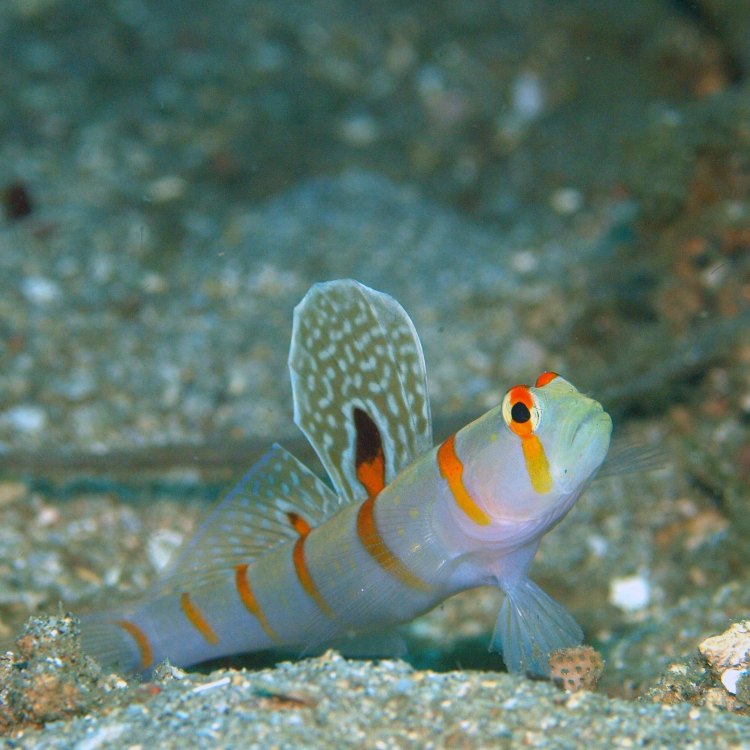
Goby Fish: The Remarkably Adaptable Creatures of the Water
Disclaimer: The content provided is for informational purposes only. We cannot guarantee the accuracy of the information on this page 100%. All information provided here may change without prior notice.







